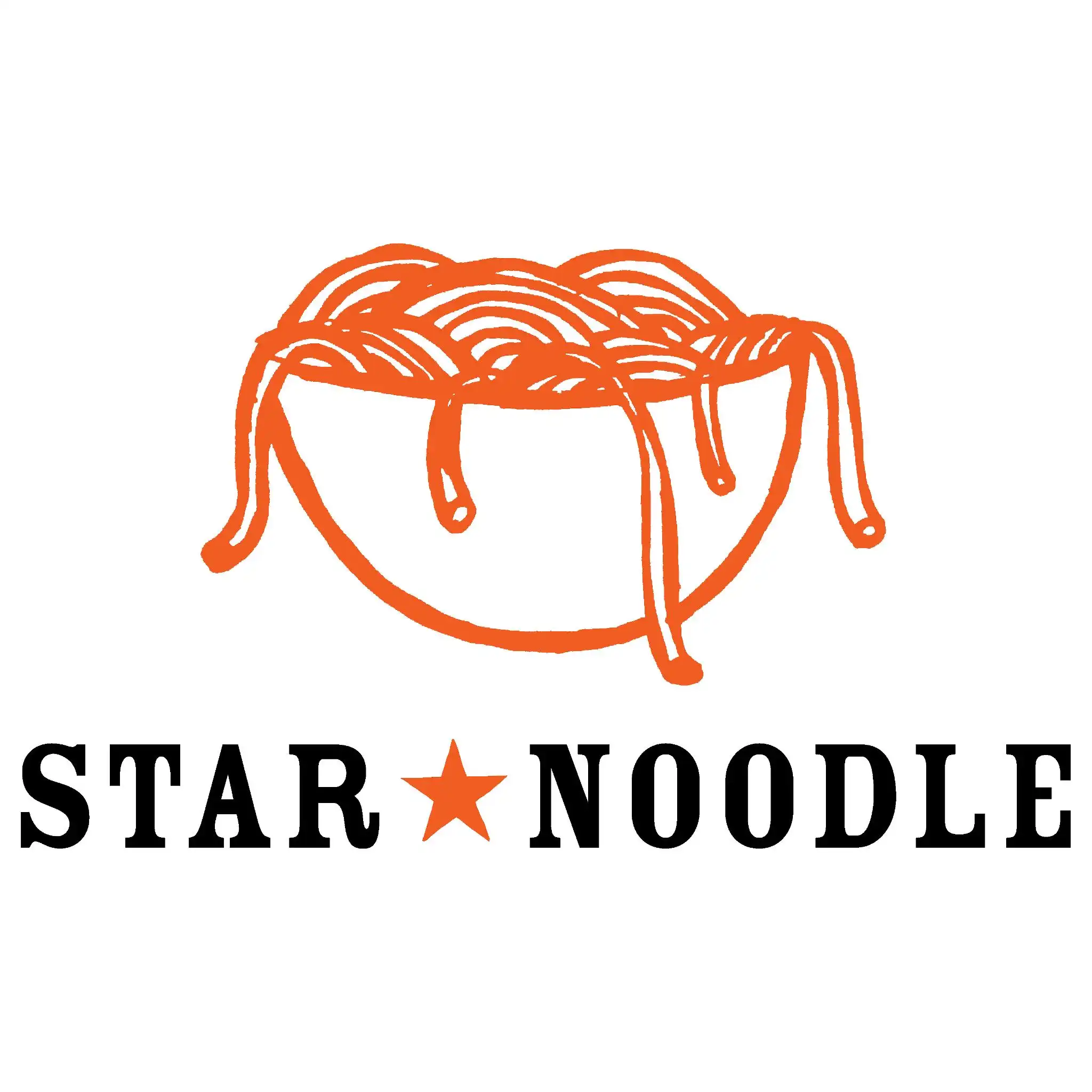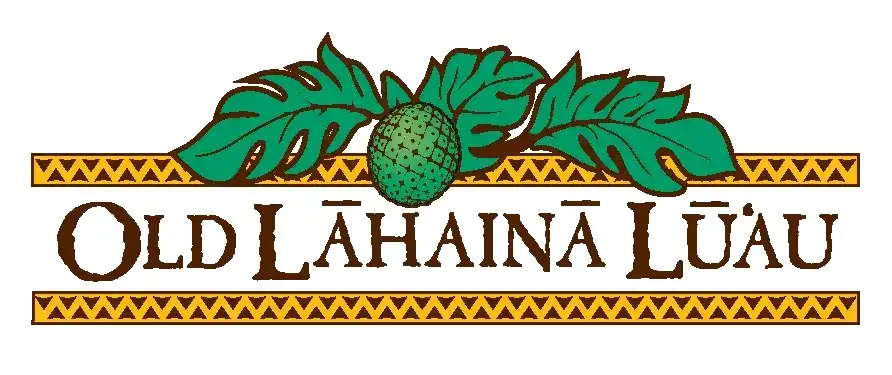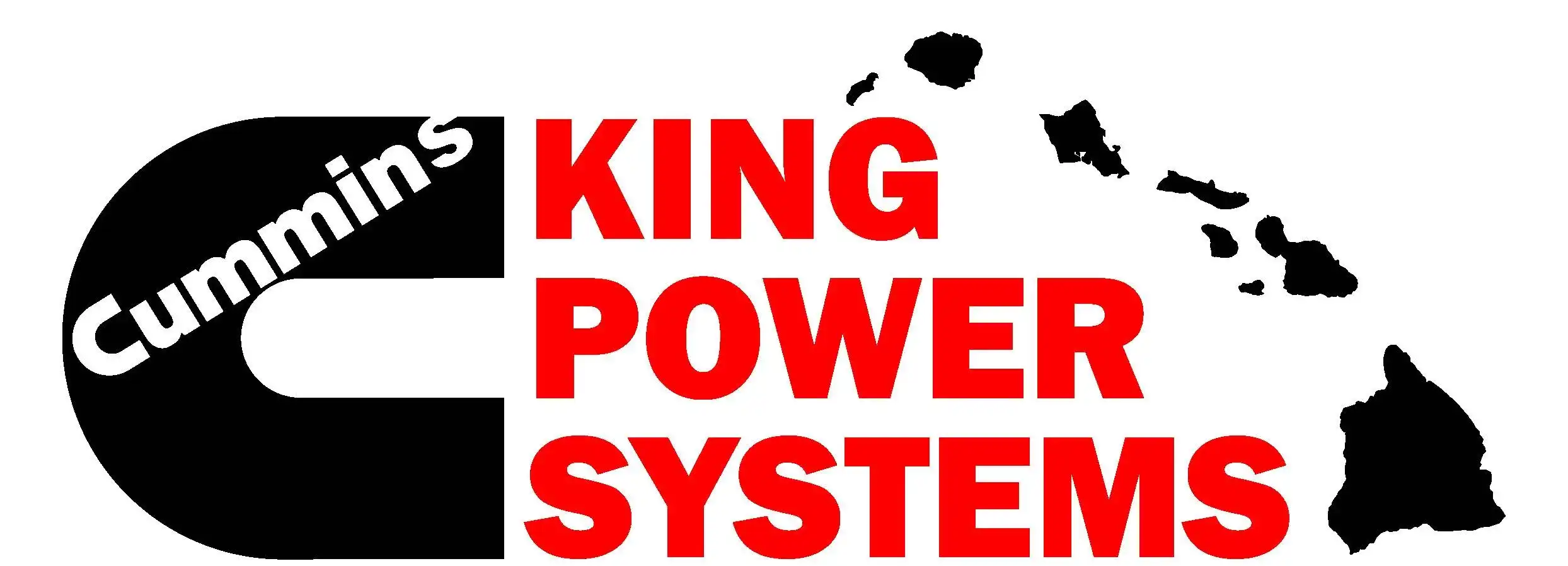Mullet Hatchery Provides New Insight at Ancient Hawaiian Fishponds
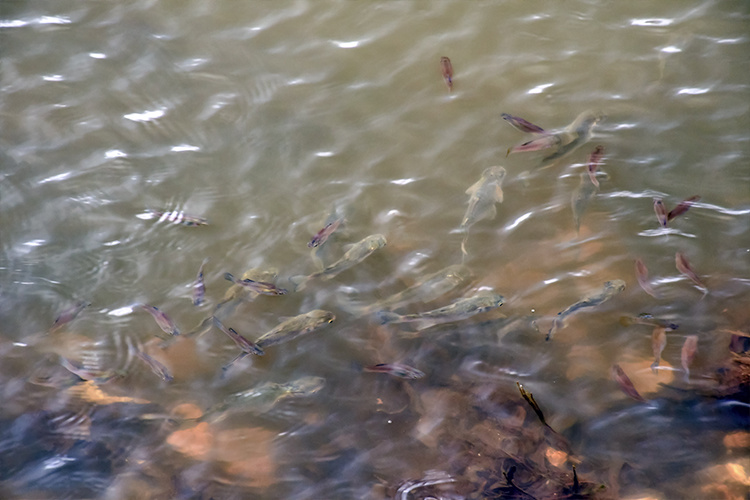
These hatchery-born mullets may help Hawaiian fishponds managers better raise their own fish recruited from the wild. PC: NOAA Fisheries
The sky was dark and overcast, but the gloomy weather belied the team’s excitement.
It was mid-morning in May, and the volunteers and staff at Heʻeia Fishpond in Kāneʻohe, Oʻahu paused their efforts clearing the fishpond’s invasive mangrove and headed towards the lower grounds of Heʻeia State Park.
As the team crossed the narrow stream separating the fishpond from the park, a flatbed truck slowly reversed towards the water’s edge. Its payload: a cylindrical container holding hundreds of juvenile ʻamaʻama, or Hawaiian striped mullet, which were born and raised in a hatchery at Hawaiʻi Pacific University’s Oceanic Institute.
“ʻAmaʻama were once the food of the people,” explained Keliʻi Kotubetey, cofounder and assistant executive director of the non-profit Paepae o Heʻeia, which manages the fishpond and is actively trying to restore it to its former glory.
Nearly a millenium ago, ancient Hawaiians developed the fishponds as a kind of natural refrigerator to trap and store mullet and other herbivorous fish, harvesting them when needed. Hawaiʻi’s fishponds have since fallen into disrepair and only a fraction of them have been restored to operational levels again. Moreoever, the aquaculture knowledge of the past has long been forgotten, and managers like Kotubetey are now trying to understand how best to raise their fish.
Herein lies the importance of the trucked-in mullets: When raised in smaller nursery areas within the fishponds, these juvenile fish provide fishpond managers with an opportunity to test what works best for their fish in a controlled setting.
“The fishponds have long been interested in receiving mullet for this project,” said Chad Callan, a marine biologist who runs OI’s Finfish Program. “But growing and delivering mullet isn’t cheap or free.”
Now, thanks to a grant provided by the NOAA Fisheries Pacific Islands Regional Office and in partnership with Conservation International, Heʻeia Fishpond, Keawanui Fishpond on Molokaʻi, and Haleolono Fishpond on Hawaiʻi Island are all receiving OI’s hatchery-born mullets.
The fishponds will rear their mullets independently and then compare notes, providing essential data about how different factors—such as fishpond location, size, and inputs like fish feed and water—affect the growth rate and health of fish.
“Every fishpond is different,” said Luka Kanakaʻole of Haleolono. “The mullet restocked at Heʻeia might grow a lot faster than those here in Hilo. Understanding these differences and how the environment affects the fish would greatly benefit the fishponds.”
This information and project could ultimately help optimize the production of the fishponds by supporting fishpond practitioners in developing pua or fingerling rearing systems that integrate traditional knowledge with the specific characteristics of each fishpond, said Ulu Ching, a Conservation International senior project manager. “The project is critical for advancing the incorporation of traditional aquaculture systems [into current food systems] to meet contemporary seafood production demand,” she added.
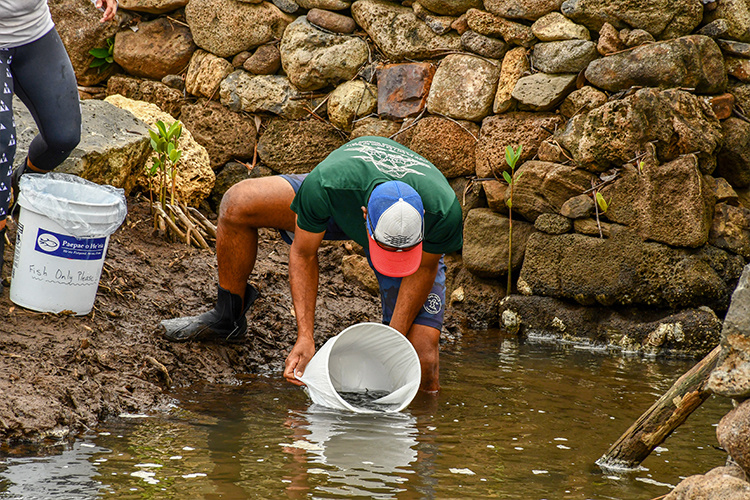
Keliʻi Kotubetey of Heʻeia Fishpond on Oʻahu introduces mullets from Oceanic Institute to their new home in the fishpond. PC: NOAA Fisheries
Valuable Lessons
Though this particular project is new, the fishponds have previously received OI’s mullets.
Heʻeia received thousands of fish a few years ago through a different grant, Kotubetey said, and these fish were released into the main fishpond instead of a nursery pond. That project, he explained, was mainly to look at the logistics and economics of restocking a fishpond with hatchery-born mullets.
Haleolono has also received fish, which taught Kanakaʻole and his team crucial lessons. For one, the fish need to be slowly acclimated to the water temperature and salinity of their new environment. Additionally, Kanakaʻole said, the mullets need to be fed a little each day until they’re used to fending for themselves.
“The tank-raised fish don’t really know what to do inside of a natural setting,” Kanakaʻole said. Feeding issues aside, the fish have a habit of gathering together in a circle and staying in place, and they therefore require constant monitoring. “When they ball up in a circle in a fishpond, it makes them easy picking for predators, particularly birds.”
The recent transfer to Heʻeia also proved to be a valuable learning experience.
After OI arrived with the mullet, volunteers and staff from OI, Heʻeia, and Conservation International scooped the fish out in buckets, and then counted and weighed them in groups before taking them to the fishpond.
About 400 juvenile mullets found a new home in the main fishpond and more than 300 fish in the nursery pond, which is isolated from the rest of the fishpond. Though the transfer went smoothly, the fish in the nursery pond were struggling a week later, possibly due to oversaturation.
Typically, OI transfers the young fish to fishponds when they’re about 2 centimeters long and 2 months old, Callan said. But the hand-sized fish Heʻeia received in May were over a year old.
These fish were left-overs from a previous transfer, Callan said, explaining that Heʻeia received the overgrown fish because the fishpond recently completed building its nursery pond for the mullet. “The stocking in Heʻeia was just to test the process and give them some experience,” he said.
But this large size of the ʻamaʻama ultimately decreased the number of fish the nursery pond could take at once. “Because the fish were so big, there was probably too much biomass in there,” Kotubetey said. “But that’s part of the learning process: learning how much a nursey pond can handle.”
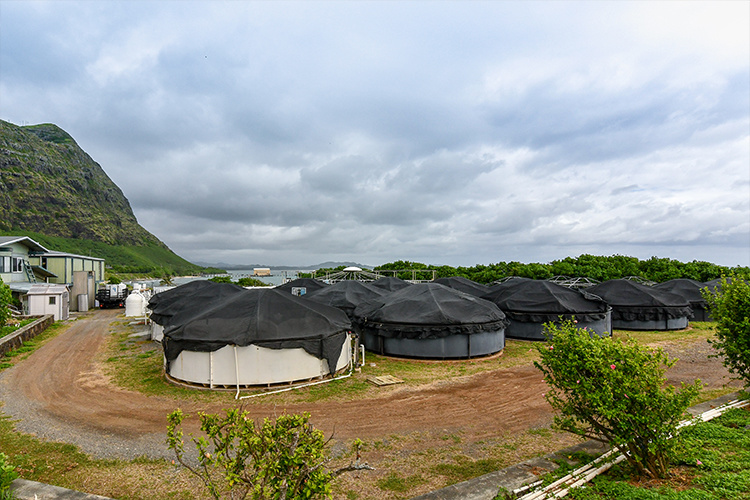
Hawaiʻi Pacific University’s Oceanic Institute rears numerous finfish species, including ʻamaʻama (Hawaiian striped mullet) and moi (Pacific threadfin), in these containers. PC: NOAA Fisheries
A Vision for the Future
The fishponds may be going through this learning process now, but OI’s practice of raising mullets has been long established.
In the 1990s, OI raised nearly 250,000 fingerling mullets at its Makapuʻu facility through a partnership with the State of Hawaiʻi. These fish were released over several years at a few sites in Hilo Harbor to boost the area’s recreational mullet fishery, which had experienced a dramatic decline in fish size and abundance since the 1940s (largely due to anthropogenic, or human-borne, impacts).
The institute’s process of farming mullets in a hatchery is the same today as it was decades ago, Callan said. It all starts with a wild-caught “broodstock”—a group of sexually mature ʻamaʻama from the wild that are used for breeding. Callan and his colleagues keep these fish in a tank at OI until winter when they naturally breed.
To breed, the females release their eggs into the tank water and the males follow suit with their sperm; with luck, the sperm will fertilize the eggs. Water flowing out of the tank passes through a net, which catches the fertilized eggs.
The mullet team then transfer the eggs into an indoor hatchery that contains numerous tanks for the various fish that OI raises. In the hatchery, the fertilized mullet eggs develop into plankton-eating larvae; when they’ve grown a bit, they switch to a diet of dry fish food and will soon be ready for fishpond life.
After the breeding season begins anew in winter 2018, Heʻeia, Keawanui, and Haleolono Fishponds will receive new baby mullets raised in this fashion.
Importantly, the walled fishponds do naturally recruit baby mullets and other small herbivorous fish from the wild (the fishpond design keeps most large carnivorous fish out). The fish swim into the fishponds seeking to feed on algae, which grows proliferously thanks to nutrient-rich brackish water, a mixture of seawater and freshwater from a watershed. When the fish mature, they become too large to fit through the grated sluice gates from which they entered the ponds.
But the level of wild mullet recruitment of most fishponds pales in comparison to ages past, partly due to the same anthropogenic issues that plagued the mullet fisheries decades ago. And the recruited fish, free to roam the entire fishpond, are very difficult to monitor. “We can’t get a good, accurate understanding of the fish and the overall fishpond,” Kanakaʻole said.
The new NOAA-backed project will change this, helping the fishpond managers acquire the aquaculture knowledge necessary to increase fishpond production.
The production will further benefit from the marriage of new and old approaches, such as kilo, the ancient Hawaiian observational practice of carefully watching and listening to the nuances of the environment to help guide resource management decisions. “This project empowers our partners to co-develop fish and environmental monitoring methodologies that are aligned with traditional customs and practices (including traditional kilo practices) and also take advantage of modern techniques and resources,” Ching from Conservation International said.
These efforts will allow the fishponds to achieve a long-held goal.
Today, most Hawaiʻi fishponds are managed as learning centers. “A fishpond is a perfect center for students to learn about the natural coastal ecosystems of Hawaiʻi,” Kanakaʻole explained, adding that Haleolono and other fishponds are not yet economically sustainable. The vision, Kotubetey said, is for as many fishponds as possible to be in production and for them to become an integral and sustainable part of Hawaiʻi’s food systems.
“It’s a lofty vision and it’s a challenging vision, given our environment,” Kotubetey said. But receiving the mullet from OI and NOAA Fisheries “shows that there’s interest in reviving Hawaiian fishpond aquaculture and production, and not just from the community level but also the private sector and the government.”
A new NOAA-funded project is helping managers of Hawaiian fishponds learn how best to raise their fish and ultimately improve production of the traditional aquaculture systems. Video produced by Joseph Bennington-Castro.
Story by Joseph Bennington-Castor, NOAA Fisheries Pacific Islands Regional Office Senior Science Writer




